
Designer rekindles effort to provide housing in the country of his birth

Associate Editor
Masum Azizi, AIA, dreams that through his connections, experience, and craft he can help the people of his native Afghanistan by building "proper shelters and villages" for its most vulnerable citizens.
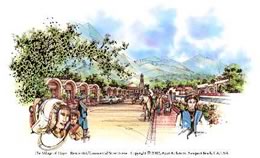 Azizi
has created and designed The Village of Hope, a project that would provide
earthquake-resistant dwellings for homeless people in a war-ravaged land.
He has spent decades thinking, planning, and strategizing, and now, more
than ever, he sees and feels the urgency of his mission. With thousands
of skilled and willing laborers already enlisted, he is seeking the political
and financial support to make his dream a reality.
Azizi
has created and designed The Village of Hope, a project that would provide
earthquake-resistant dwellings for homeless people in a war-ravaged land.
He has spent decades thinking, planning, and strategizing, and now, more
than ever, he sees and feels the urgency of his mission. With thousands
of skilled and willing laborers already enlisted, he is seeking the political
and financial support to make his dream a reality.
You have to start
someplace
The California architect, who optimistically says you have to "start
someplace and somehow," has used his own resources to develop plans
for prototype shelters and villages that use indigenous materials and
apply traditional architectural styles and building methods. The designs
take into account the limited availability of building materials as well
as local workers' familiarity with construction techniques.
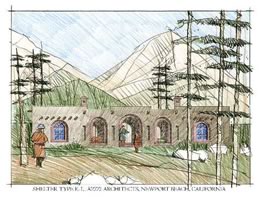 The
plans call for alternating square, rectangular, and circular shelters
with two family rooms, a guestroom, a toilet and washroom, and a kitchen
with a private courtyard. The dwelling would house a family of 8 to 12
people and be accessible to people with disabilities.
The
plans call for alternating square, rectangular, and circular shelters
with two family rooms, a guestroom, a toilet and washroom, and a kitchen
with a private courtyard. The dwelling would house a family of 8 to 12
people and be accessible to people with disabilities.
Azizi comes from a builder family in Afghanistan and learned the trade from his late father. (He became an architect later.) He based his designs on his own extensive research on traditional building crafts that have proved their worthiness over centuries. He also considered the country's topographical and climatic conditions. The earthquakes and water erosion common in Afghanistan are no strangers to an architect who has worked a dozen years in California.
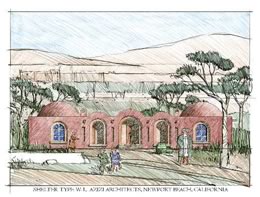 Native
son
Native
son
Afghanistan is divided into two major regions, Azizi explained: "westerly,"
where domes and vaulted structures are prevalent, and "easterly,"
where flat roofs are common. These traditions dictate construction type
for schools, orphanages, clinics, mosques, libraries, offices, and shops,
all of which would be in walking distance of the homes. The size of each
village would be between 500 to 2,500 dwellings.
His studies and his architecture practice serve him well for his current undertaking. Azizi, who earned his degree in architecture from Kabul University, began graduate studies on scholarship in Copenhagen as the Soviets were invading Afghanistan in 1979–1980. After receiving his degree in historic building restoration from The Royal Danish Academy of Fine Arts, he considered returning to his homeland, but family and friends still living there advised against it. Instead, he followed an older brother to Atlanta and began working in architecture firms in the U.S. He moved to Newport Beach, Calif., in 1990 and became a U.S. citizen in 1995.
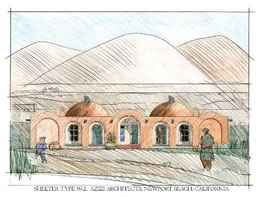 Since
coming to the U.S., Azizi has served as project architect/manager at several
architecture firms and directed environmental and historic preservation
efforts for the Federal Emergency Management Agency and the California
Office of Emergency Services. He earned the 1997 California Historic Preservation
award for the restoration of Powel Library at UCLA. And in 1998, he founded
Azizi Architects, a small practice specializing in custom-home and clubhouse
design, historic preservation, and damage and recovery assessment.
Since
coming to the U.S., Azizi has served as project architect/manager at several
architecture firms and directed environmental and historic preservation
efforts for the Federal Emergency Management Agency and the California
Office of Emergency Services. He earned the 1997 California Historic Preservation
award for the restoration of Powel Library at UCLA. And in 1998, he founded
Azizi Architects, a small practice specializing in custom-home and clubhouse
design, historic preservation, and damage and recovery assessment.
While his personal prospects were looking up, the outlook for his birthplace was bleak. First his country was ravaged by the Soviets, next the Taliban destroyed the nation's most revered structures, then its most commonplace, such as houses and schools. In this climate, Azizi said he tried to discuss his proposals for housing development with Northern Alliance officials, but the country's tenuous political situation hindered his efforts.
Defeat of the Taliban this winter, however, has provided Azizi and his supporters with a window of opportunity and renewed hope that their plan can and will succeed.
"Finally," Azizi said, "as of last October, what we see is some hope for the people of Afghanistan."
Design guidelines
preserve tradition
Azizi, who visited family in refugee camps in 1992 but has not returned
to his homeland since he left more than two decades ago, is full of conviction
and is eager to pass the country's traditions on to future generations.
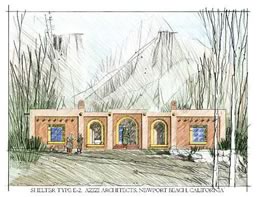 As
better materials become available, health, safety, and welfare conditions
would improve, Azizi noted. For example, before the situation deteriorated
in Afghanistan, the country produced high-quality cement. If its three
factories open again, over time the project can begin to introduce the
material to strengthen walls and make them more water-resistant.
As
better materials become available, health, safety, and welfare conditions
would improve, Azizi noted. For example, before the situation deteriorated
in Afghanistan, the country produced high-quality cement. If its three
factories open again, over time the project can begin to introduce the
material to strengthen walls and make them more water-resistant.
Construction specifications and the structural design requirements are based on the structural load calculations and requirements of the earthquake-prone western/Pacific region of the U.S. and on waterproofing methods that improve drainage, and prevent leakage and moisture damage.
Energy efficiency and sustainable design is also important to Azizi. He considered the orientation of the buildings and incorporated traditional heating and cooling techniques within the shelter design. Cool winds that blow from the west are collected through vents on the roof (baddgeer) and channeled through inside walls, pushing hot air out. The heating system employs a clay oven (tanoor) in the kitchen, where the heat generated is channeled under the floor to heat stone-slab floors in the winter. Thick adobe walls also help regulate the temperature. Azizi's program calls for a ceramic water closet that drains to a cesspool so that waste does not contaminate the water supply.
Making dreams reality
"The faster the project gets off the ground," Azizi said, "people
can start their lives, keep adding to their lives." To this end,
Azizi and his staff are putting aside other work and have hired environmental
planners and other professionals, he told the Los
Angeles Times.
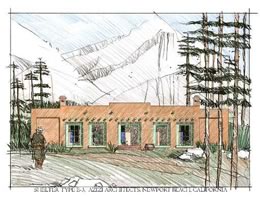 Azizi
said he has finished the design plans and will now spend the next months
finishing specific blueprints that show, step-by-step, how to prepare
the materials and build the shelters and villages. Documents will be presented
in English and Dari, one of Afghanistan's primary languages.
Azizi
said he has finished the design plans and will now spend the next months
finishing specific blueprints that show, step-by-step, how to prepare
the materials and build the shelters and villages. Documents will be presented
in English and Dari, one of Afghanistan's primary languages.
The shelters and the jobs created by their construction would help bring funds into the villages and boost Afghanistan's economy, Azizi told AIArchitect. He says that at the beginning stages of the project it would take four masons 35 days to build a small home at the cost of $5,500. Practice would reduce the construction time to 17 days and a cost of $4,500.
As if these dreams weren't enough, Azizi believes that the "Santa Fe" style of architecture could be adapted and used to provide housing relief worldwide.
He has made presentations about his program to several California politicians, including U.S. Sen. Barbara Boxer (D) and Rep. Dana Rohrabacher (R), both of whom received the architect's ideas enthusiastically, he said. Azizi is now ready to take his ideas to international aid and development organizations like USAID, the World Bank, and the United Nations to ask for money and resources. He said he is willing to implement his proposals himself or to partner on this "crucial and much needed project."
The opening of a branch office in Kabul is in the works, Azizi said. His architect nephew, builder cousins, and former school colleagues will staff it, and he will travel between the U.S. and Afghanistan. But a date for Azizi's initial trip back has not been set.
Skeptics watch out. This is a man on a mission.
Copyright 2002 The American Institute of Architects. All rights reserved.
![]()
|
Contact Masum Azizi, AIA, through his Web site or email. Images courtesy of the architect. |
|